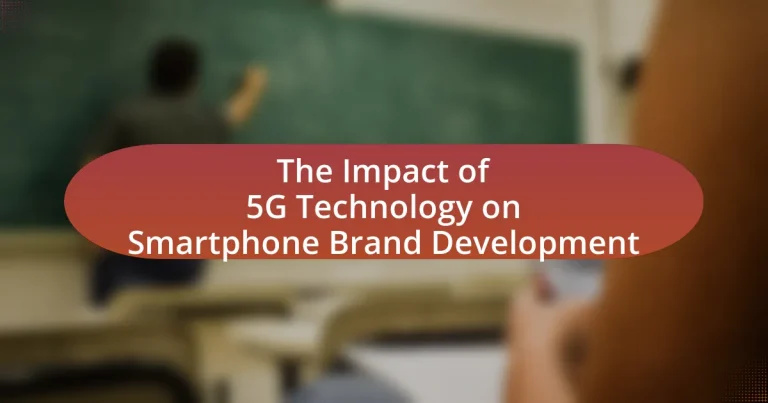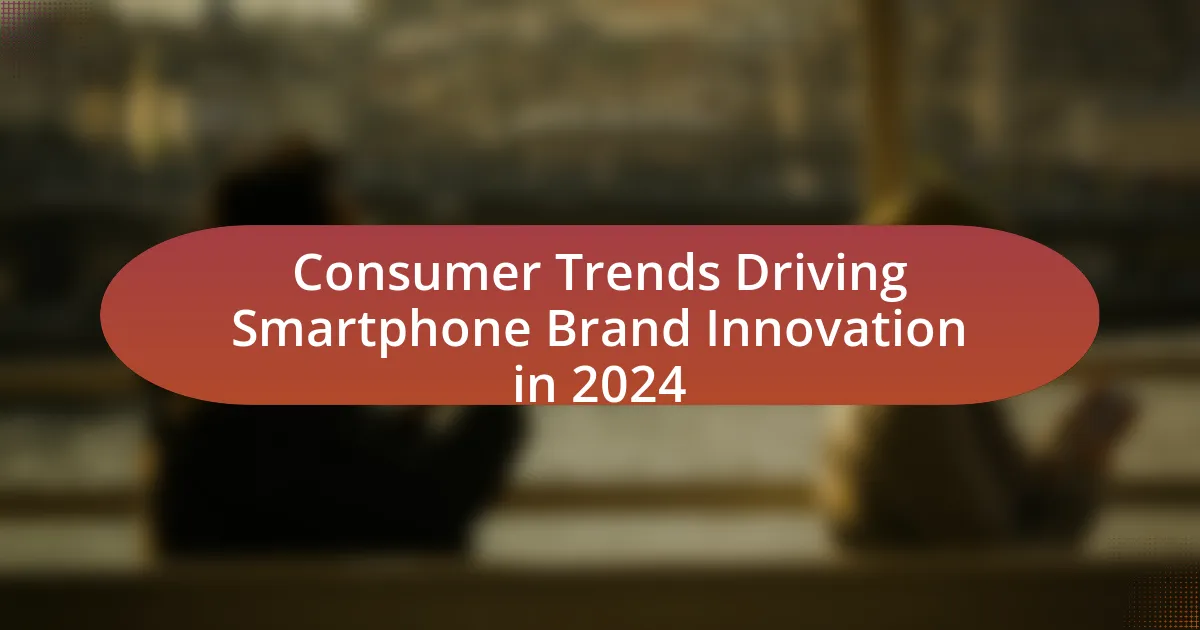The article examines the impact of 5G technology on smartphone brand development, highlighting how faster data speeds, improved connectivity, and enhanced user experiences drive innovation among manufacturers. It discusses the influence of 5G on smartphone features, competitive advantages for brands, and the challenges faced during implementation. Additionally, the article explores how 5G reshapes marketing strategies, affects consumer perceptions, and influences pricing and design trends. Key insights include the importance of partnerships for successful integration and the long-term effects of 5G on brand loyalty and consumer engagement.
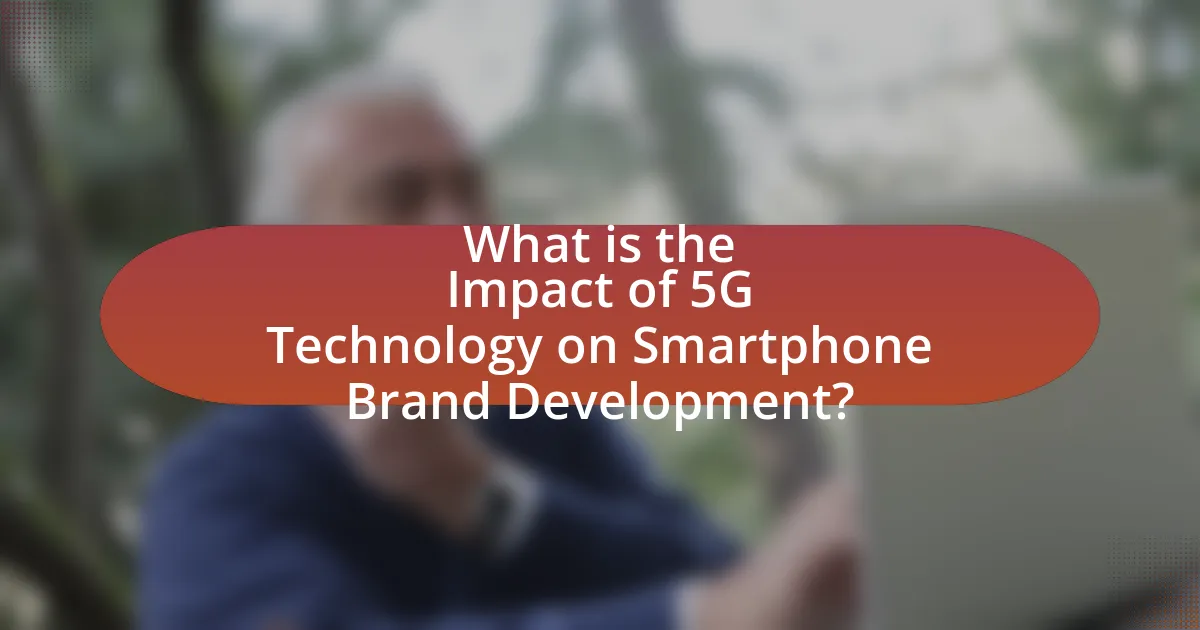
What is the Impact of 5G Technology on Smartphone Brand Development?
5G technology significantly influences smartphone brand development by enabling faster data speeds, improved connectivity, and enhanced user experiences. This advancement compels brands to innovate their devices, integrating features that leverage 5G capabilities, such as augmented reality and advanced gaming. For instance, a report by Ericsson indicates that 5G networks can deliver speeds up to 100 times faster than 4G, prompting brands to differentiate themselves through superior performance and new functionalities. Consequently, smartphone manufacturers are investing heavily in 5G technology to attract consumers seeking cutting-edge capabilities, thereby reshaping brand strategies and market positioning.
How does 5G Technology influence smartphone features and capabilities?
5G technology significantly enhances smartphone features and capabilities by enabling faster data speeds, lower latency, and improved connectivity. This advancement allows smartphones to support high-definition streaming, augmented reality applications, and seamless online gaming experiences. For instance, 5G networks can achieve download speeds exceeding 1 Gbps, which is substantially faster than 4G, facilitating quicker access to cloud services and real-time data processing. Additionally, the reduced latency of 5G, often below 10 milliseconds, enhances user interactions in applications requiring instant feedback, such as remote gaming and virtual reality. These improvements drive smartphone manufacturers to innovate, integrating advanced hardware and software to leverage 5G capabilities, ultimately influencing brand development and market competitiveness.
What new functionalities does 5G enable for smartphones?
5G enables smartphones to achieve significantly faster data speeds, lower latency, and enhanced connectivity. These improvements allow for seamless streaming of high-definition content, real-time gaming experiences, and the ability to connect multiple devices simultaneously without degradation in performance. For instance, 5G can provide download speeds exceeding 1 Gbps, which is up to 100 times faster than 4G, facilitating quicker app downloads and smoother video calls. Additionally, the reduced latency of around 1 millisecond enhances applications like augmented reality and virtual reality, making them more responsive and immersive.
How does 5G affect smartphone performance and user experience?
5G significantly enhances smartphone performance and user experience by providing faster data speeds, lower latency, and improved connectivity. With 5G, smartphones can achieve download speeds exceeding 1 Gbps, which is up to 100 times faster than 4G, allowing for seamless streaming, quicker app downloads, and enhanced gaming experiences. Additionally, 5G reduces latency to as low as 1 millisecond, which improves real-time interactions in applications like video calls and online gaming. This technology also supports a greater number of connected devices simultaneously, ensuring that users experience consistent performance even in crowded areas. The combination of these factors leads to a more responsive and efficient user experience, ultimately influencing smartphone brand development as manufacturers prioritize 5G capabilities in their devices to meet consumer demand for advanced performance.
Why is 5G Technology important for smartphone brands?
5G technology is important for smartphone brands because it significantly enhances data speeds and connectivity, enabling advanced features and applications. With 5G, smartphone brands can offer improved user experiences through faster downloads, lower latency, and the ability to support more connected devices simultaneously. For instance, 5G networks can deliver speeds up to 100 times faster than 4G, allowing for seamless streaming of high-definition content and enhanced gaming experiences. This technological advancement not only attracts consumers seeking cutting-edge devices but also positions brands competitively in a rapidly evolving market where connectivity is paramount.
What competitive advantages do brands gain from adopting 5G?
Brands gain significant competitive advantages from adopting 5G technology, primarily through enhanced connectivity, improved customer experiences, and increased operational efficiency. Enhanced connectivity allows brands to offer faster data transfer rates, enabling seamless streaming and real-time interactions, which can lead to higher customer satisfaction and retention. Improved customer experiences are facilitated by low latency, allowing for applications such as augmented reality and virtual reality, which can differentiate a brand in a crowded market. Increased operational efficiency is achieved through the ability to connect more devices simultaneously, optimizing supply chain management and reducing costs. According to a report by Ericsson, 5G can increase mobile broadband speeds by up to 100 times compared to 4G, providing brands with the technological edge needed to innovate and meet evolving consumer demands.
How does 5G adoption affect brand perception among consumers?
5G adoption positively affects brand perception among consumers by enhancing their expectations for speed, connectivity, and innovation. As consumers experience faster download speeds and improved network reliability, they associate these advancements with brands that offer 5G-enabled devices, leading to a perception of technological leadership and modernity. Research from Deloitte indicates that 5G technology is expected to drive consumer interest in new devices, with 61% of consumers stating that they would be more likely to purchase a smartphone that supports 5G. This heightened interest translates into increased brand loyalty and preference for companies that prioritize 5G capabilities, reinforcing their market position.
What challenges do smartphone brands face with 5G implementation?
Smartphone brands face significant challenges with 5G implementation, primarily related to infrastructure, cost, and consumer adoption. The infrastructure challenge arises from the need for extensive network upgrades and the deployment of new technologies, such as small cells, which are essential for 5G coverage. This requires substantial investment from both telecom providers and smartphone manufacturers.
Cost is another major hurdle, as integrating 5G technology into devices increases production expenses, which can lead to higher retail prices. For instance, the average cost of 5G smartphones is approximately 20% higher than their 4G counterparts, impacting market competitiveness.
Lastly, consumer adoption poses a challenge, as many users may not see immediate benefits or may be hesitant to upgrade due to the perceived lack of 5G-compatible content and applications. According to a survey by Deloitte, only 29% of consumers expressed a strong interest in purchasing a 5G device in 2020, indicating a gap in market readiness. These factors collectively hinder the seamless transition to 5G technology for smartphone brands.
What are the technological hurdles in integrating 5G into smartphones?
The technological hurdles in integrating 5G into smartphones include the need for advanced hardware, increased power consumption, and the complexity of network compatibility. Advanced hardware is required to support the higher frequencies and bandwidths of 5G, necessitating new chipsets and antennas that can handle these specifications. Increased power consumption is a significant concern, as 5G technology demands more energy, which can lead to shorter battery life unless improvements in battery technology are made. Additionally, the complexity of ensuring compatibility with existing 4G networks and various 5G standards poses challenges for manufacturers, as they must develop devices that can seamlessly transition between different network types while maintaining performance.
How do market dynamics impact the rollout of 5G smartphones?
Market dynamics significantly influence the rollout of 5G smartphones by determining consumer demand, pricing strategies, and competition among manufacturers. For instance, as consumer interest in faster internet speeds and enhanced connectivity grows, manufacturers are incentivized to accelerate the production and release of 5G devices to capture market share. Additionally, competitive pressures compel companies to innovate and offer 5G smartphones at various price points, making them accessible to a broader audience. According to a report by Counterpoint Research, global 5G smartphone shipments reached 524 million units in 2021, reflecting the rapid adoption driven by these market dynamics.
How does 5G Technology reshape marketing strategies for smartphone brands?
5G technology reshapes marketing strategies for smartphone brands by enabling enhanced user experiences and facilitating innovative marketing approaches. The increased speed and lower latency of 5G allow brands to showcase high-definition content, such as augmented reality (AR) and virtual reality (VR) applications, which can engage consumers more effectively. For instance, smartphone brands can utilize 5G to deliver immersive advertising experiences that were previously impractical, leading to higher consumer engagement and conversion rates. According to a report by Ericsson, 5G is expected to support up to 1 million devices per square kilometer, allowing brands to leverage IoT capabilities for personalized marketing strategies. This connectivity fosters real-time data collection and analysis, enabling brands to tailor their offerings based on consumer behavior and preferences, ultimately driving sales and brand loyalty.
What messaging strategies are effective for promoting 5G smartphones?
Effective messaging strategies for promoting 5G smartphones include emphasizing speed, connectivity, and enhanced user experiences. Highlighting the significant increase in data transfer rates, which can reach up to 10 Gbps, showcases the technology’s capability to support high-definition streaming, gaming, and seamless multitasking. Additionally, focusing on the benefits of low latency, which can be as low as 1 millisecond, illustrates how 5G enhances real-time applications like augmented reality and virtual reality.
Utilizing customer testimonials and case studies can further validate these claims, as research indicates that 5G can improve mobile experiences significantly compared to 4G. Furthermore, targeting specific demographics, such as gamers and content creators, with tailored messaging that speaks to their unique needs can increase engagement and conversion rates.
How can brands leverage 5G to enhance customer engagement?
Brands can leverage 5G technology to enhance customer engagement by utilizing its high-speed connectivity and low latency to deliver immersive experiences. For instance, brands can implement augmented reality (AR) and virtual reality (VR) applications that require fast data transfer, allowing customers to interact with products in real-time. According to a report by Ericsson, 5G can provide up to 100 times faster data speeds compared to 4G, enabling seamless streaming of high-definition content and interactive applications. This capability allows brands to create personalized marketing campaigns and interactive experiences that resonate with consumers, ultimately driving higher engagement levels.
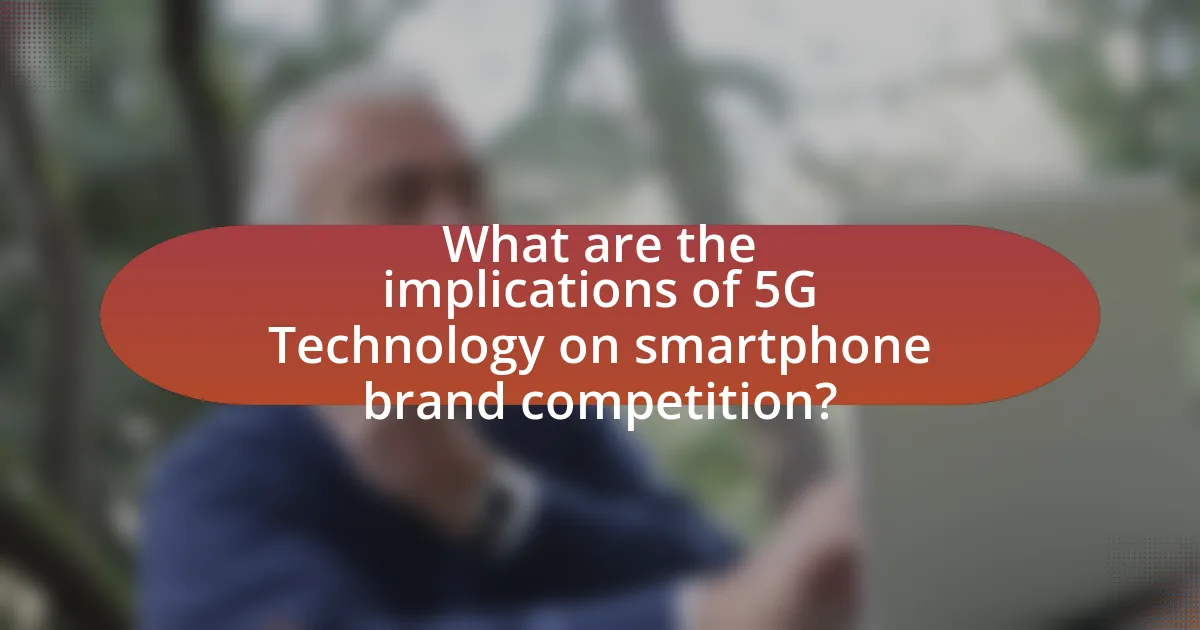
What are the implications of 5G Technology on smartphone brand competition?
5G technology significantly intensifies competition among smartphone brands by enabling faster data speeds, lower latency, and enhanced connectivity features. This technological advancement compels brands to innovate rapidly, as consumers increasingly demand devices that can leverage 5G capabilities for improved performance in applications like streaming, gaming, and augmented reality. For instance, according to a report by GSMA Intelligence, the global 5G smartphone market is projected to reach 1.5 billion units by 2025, highlighting the urgency for brands to adopt 5G to remain competitive. Consequently, brands that effectively integrate 5G technology into their offerings can differentiate themselves, attract tech-savvy consumers, and capture a larger market share, while those that lag may face declining relevance in a rapidly evolving market.
How does 5G Technology affect market positioning among smartphone brands?
5G technology significantly enhances market positioning among smartphone brands by enabling faster data speeds, lower latency, and improved connectivity features. Brands that adopt 5G capabilities can differentiate themselves in a competitive market, attracting tech-savvy consumers who prioritize high-performance devices. For instance, according to a report by Counterpoint Research, 5G smartphones accounted for over 50% of global smartphone sales in 2022, indicating a strong consumer preference for devices equipped with this technology. Consequently, brands that lead in 5G adoption, such as Samsung and Apple, strengthen their market share and brand loyalty, while those lagging behind risk losing relevance in an increasingly connected world.
What strategies do leading brands use to capitalize on 5G?
Leading brands capitalize on 5G by enhancing user experiences through faster data speeds, improved connectivity, and innovative applications. For instance, companies like Samsung and Apple integrate 5G capabilities into their latest smartphone models, allowing for seamless streaming, gaming, and augmented reality experiences. Additionally, brands invest in partnerships with telecom providers to ensure widespread 5G network availability, which boosts customer satisfaction and loyalty. According to a report by Ericsson, 5G subscriptions are expected to reach 3.5 billion by 2026, indicating a significant market opportunity for brands that effectively leverage this technology.
How does 5G influence pricing strategies for smartphones?
5G technology significantly influences pricing strategies for smartphones by allowing manufacturers to justify higher price points due to enhanced features and capabilities. The introduction of 5G enables faster data speeds, improved connectivity, and advanced functionalities, which manufacturers leverage to position their devices as premium offerings. For instance, research from Counterpoint Technology Market Research indicates that 5G smartphones are priced approximately 20-30% higher than their 4G counterparts, reflecting the added value perceived by consumers. This pricing strategy not only aims to recoup the investment in 5G technology but also aligns with consumer expectations for cutting-edge performance and future-proofing their devices.
What role does consumer demand play in the development of 5G smartphones?
Consumer demand significantly drives the development of 5G smartphones by influencing manufacturers’ design, features, and pricing strategies. As consumers increasingly seek faster internet speeds and enhanced connectivity, smartphone brands prioritize 5G capabilities to meet these expectations. For instance, a report by Counterpoint Research indicates that 5G smartphone sales are projected to reach over 1.5 billion units by 2025, reflecting strong consumer interest in this technology. This demand compels manufacturers to innovate and invest in 5G technology, ensuring their products remain competitive in a rapidly evolving market.
How do consumer expectations shape smartphone features in a 5G era?
Consumer expectations significantly shape smartphone features in the 5G era by driving demand for enhanced connectivity, speed, and functionality. As consumers anticipate faster download and upload speeds, manufacturers prioritize integrating advanced processors and improved antennas to meet these expectations. For instance, a survey by Deloitte in 2021 indicated that 70% of consumers consider 5G capability essential when purchasing a new smartphone, prompting brands to innovate features like multi-band support and improved battery life to accommodate the increased data usage associated with 5G networks. This alignment between consumer expectations and smartphone features ultimately influences brand development strategies, as companies strive to differentiate themselves in a competitive market.
What demographic trends are influencing 5G smartphone adoption?
Younger demographics, particularly millennials and Gen Z, are significantly influencing 5G smartphone adoption due to their high engagement with technology and preference for faster connectivity. These age groups prioritize mobile internet speed for activities such as streaming, gaming, and social media, driving demand for 5G-enabled devices. Additionally, urban populations are adopting 5G smartphones at a higher rate, as these areas typically have better infrastructure and service availability. According to a report by the GSMA, 5G connections are expected to reach 1.7 billion by 2025, with a substantial portion coming from younger users in metropolitan regions.
How do partnerships and collaborations impact 5G smartphone development?
Partnerships and collaborations significantly accelerate 5G smartphone development by pooling resources, expertise, and technology. For instance, collaborations between smartphone manufacturers and telecom companies enable the integration of advanced 5G technologies, ensuring devices are optimized for network performance. A notable example is the partnership between Qualcomm and various smartphone brands, which has led to the rapid deployment of 5G-capable chipsets, facilitating faster development cycles. Additionally, collaborations with software developers enhance user experience through optimized applications that leverage 5G capabilities, further driving consumer adoption. These strategic alliances ultimately lead to more innovative and competitive 5G smartphones in the market.
What types of partnerships are essential for successful 5G integration?
Successful 5G integration requires partnerships between telecommunications companies, technology providers, and regulatory bodies. Telecommunications companies are essential for infrastructure development and network deployment, while technology providers contribute innovative hardware and software solutions necessary for 5G functionality. Regulatory bodies ensure compliance with standards and facilitate spectrum allocation, which is critical for effective network operation. These partnerships enable the sharing of resources, expertise, and technology, ultimately leading to a robust 5G ecosystem that supports smartphone brand development and enhances user experiences.
How do collaborations with telecom companies enhance brand development?
Collaborations with telecom companies enhance brand development by providing smartphone brands access to advanced network technologies and marketing channels. These partnerships enable brands to showcase their devices’ capabilities, particularly in leveraging 5G technology, which offers faster speeds and improved connectivity. For instance, brands like Samsung and Apple have partnered with telecom providers to launch 5G-enabled devices, resulting in increased visibility and consumer interest. According to a report by Counterpoint Research, brands that effectively collaborate with telecom companies can see a 20% increase in sales during the launch of new 5G devices, demonstrating the significant impact of such collaborations on brand growth and market presence.
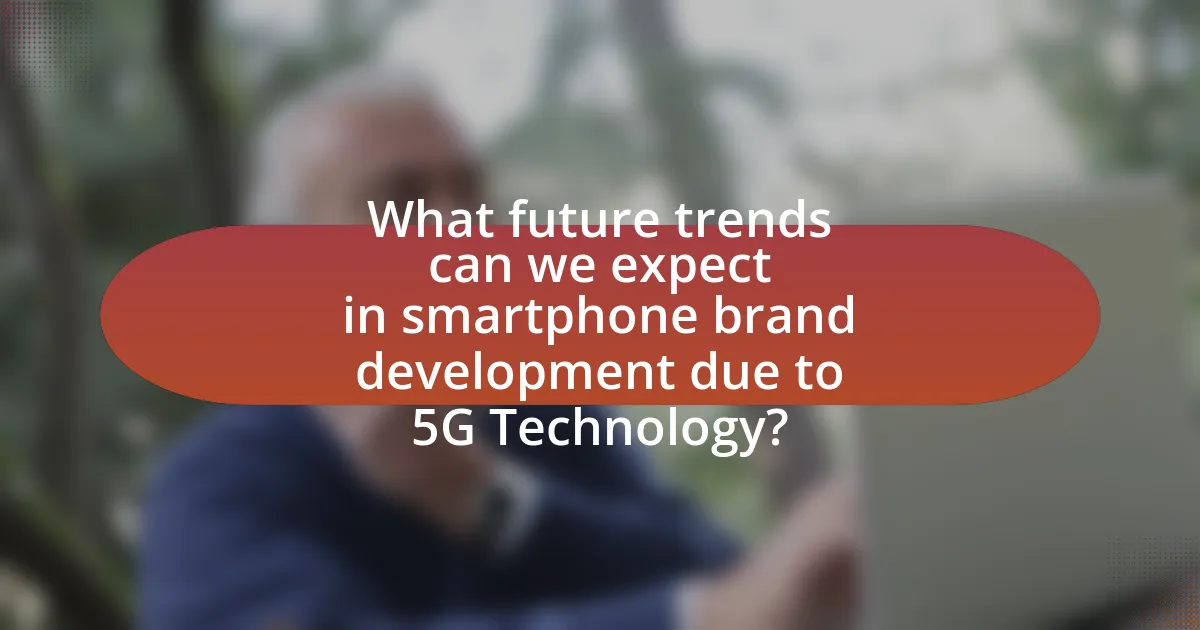
What future trends can we expect in smartphone brand development due to 5G Technology?
Smartphone brand development will increasingly focus on enhanced connectivity, advanced features, and improved user experiences due to 5G technology. As 5G networks offer significantly faster data speeds and lower latency, brands will prioritize the integration of features that leverage these capabilities, such as augmented reality (AR) and virtual reality (VR) applications, which require high bandwidth.
Additionally, brands will likely invest in developing devices that support multi-device connectivity, enabling seamless integration with smart home devices and wearables. According to a report by GSMA, the global 5G connections are expected to reach 1.7 billion by 2025, indicating a strong market demand for 5G-enabled smartphones. This demand will drive brands to innovate in areas like camera technology and battery life, ensuring devices can handle the increased data load while maintaining performance.
Furthermore, competition among smartphone manufacturers will intensify, leading to more aggressive pricing strategies and marketing campaigns aimed at highlighting 5G capabilities. As a result, brands that effectively communicate their 5G advantages will likely gain a competitive edge in the market.
How will 5G Technology influence the evolution of smartphone design?
5G technology will significantly influence the evolution of smartphone design by enabling faster data speeds and lower latency, which will drive manufacturers to create devices that can fully utilize these capabilities. As a result, smartphones will likely feature enhanced processing power, improved battery life, and advanced cooling systems to support high-performance applications such as augmented reality and high-definition streaming. For instance, Qualcomm’s Snapdragon 888 processor, which supports 5G, allows for more efficient multitasking and graphics rendering, pushing designers to innovate in form factors and materials to accommodate these advancements. Additionally, the demand for 5G connectivity will lead to the integration of more sophisticated antennas and components, prompting a shift towards sleeker designs that maintain functionality without compromising aesthetics.
What innovations in hardware are driven by 5G capabilities?
5G capabilities drive innovations in hardware such as enhanced antennas, advanced chipsets, and improved battery technology. Enhanced antennas, including Massive MIMO (Multiple Input Multiple Output), enable devices to handle higher data rates and improved signal quality, which is essential for 5G performance. Advanced chipsets, like Qualcomm’s Snapdragon 888, integrate 5G modems directly into the processor, optimizing power efficiency and performance. Improved battery technology, including fast-charging solutions, supports the increased energy demands of 5G connectivity. These innovations collectively enhance user experience and device functionality, aligning with the growing demand for high-speed mobile internet.
How might software development change with the advent of 5G?
Software development will change significantly with the advent of 5G by enabling faster data transfer rates, lower latency, and improved connectivity, which will facilitate the creation of more complex and data-intensive applications. The increased bandwidth of 5G allows developers to implement features such as real-time data processing, enhanced augmented reality experiences, and seamless integration of IoT devices. For instance, 5G networks can support up to 1 million devices per square kilometer, compared to 4G’s 100,000, which means software can be designed to leverage this vast connectivity for smarter applications. Additionally, the reduced latency of 5G, which can be as low as 1 millisecond, will enhance user experiences in applications requiring immediate feedback, such as gaming and remote surgery. This transformation in software development will lead to innovative solutions that were previously impractical under 4G technology constraints.
What are the potential long-term effects of 5G on smartphone brand loyalty?
The potential long-term effects of 5G on smartphone brand loyalty include increased consumer retention and a shift in brand preference towards companies that effectively leverage 5G technology. As 5G networks enhance mobile experiences through faster speeds and lower latency, consumers are likely to develop stronger attachments to brands that provide superior connectivity and innovative applications. Research indicates that brands that successfully integrate 5G capabilities into their devices can differentiate themselves in a competitive market, leading to higher customer satisfaction and loyalty. For instance, a study by Deloitte found that 5G adoption could significantly influence consumer purchasing decisions, with 70% of respondents indicating they would consider upgrading to a 5G-enabled device from a brand they trust. This trend suggests that brands that prioritize 5G technology may cultivate a loyal customer base over time.
How can brands build lasting relationships with consumers in a 5G landscape?
Brands can build lasting relationships with consumers in a 5G landscape by leveraging enhanced connectivity to deliver personalized experiences and real-time engagement. The high-speed and low-latency capabilities of 5G enable brands to utilize data analytics for understanding consumer preferences and behaviors more accurately. For instance, a study by Ericsson indicates that 5G can support up to one million devices per square kilometer, allowing brands to interact with consumers through various touchpoints seamlessly. By implementing strategies such as tailored content delivery, interactive customer service, and immersive experiences like augmented reality, brands can foster deeper connections with their audience. This approach not only enhances customer satisfaction but also encourages brand loyalty, as consumers increasingly value personalized interactions in a fast-paced digital environment.
What role does customer service play in fostering brand loyalty with 5G smartphones?
Customer service plays a crucial role in fostering brand loyalty with 5G smartphones by enhancing customer satisfaction and trust. Effective customer service addresses user concerns related to the complexities of 5G technology, such as connectivity issues and device compatibility, which can significantly influence a customer’s perception of the brand. According to a study by PwC, 73% of consumers point to customer experience as an important factor in their purchasing decisions, indicating that responsive and knowledgeable support can lead to repeat purchases and brand advocacy. Furthermore, brands that provide exceptional customer service are more likely to cultivate a loyal customer base, as satisfied customers are 67% more likely to recommend the brand to others.
What best practices should smartphone brands adopt for successful 5G integration?
Smartphone brands should prioritize robust network compatibility, user experience optimization, and strategic partnerships for successful 5G integration. Ensuring devices are compatible with various 5G bands enhances connectivity and user satisfaction, as evidenced by the rapid adoption of 5G networks globally, which reached over 1 billion subscriptions by mid-2022 according to the GSMA. Optimizing user experience involves developing applications that leverage 5G’s high speeds and low latency, which can significantly improve functionalities like streaming and gaming. Additionally, forming strategic partnerships with telecom providers can facilitate better network access and marketing efforts, as seen in collaborations between major smartphone manufacturers and carriers that have successfully launched 5G services.
How can brands effectively educate consumers about 5G benefits?
Brands can effectively educate consumers about 5G benefits by utilizing targeted marketing campaigns that highlight specific advantages such as faster download speeds, lower latency, and enhanced connectivity. For instance, brands can create informative content, including videos and infographics, that demonstrate real-world applications of 5G technology, such as improved streaming quality and seamless online gaming experiences. Research from the GSMA indicates that 5G can deliver speeds up to 100 times faster than 4G, which can be a compelling point for consumers. Additionally, hosting webinars and interactive sessions can engage consumers directly, allowing them to ask questions and receive immediate feedback, thereby enhancing their understanding of 5G’s potential.
What strategies can brands implement to ensure a smooth transition to 5G?
Brands can implement several strategies to ensure a smooth transition to 5G, including investing in infrastructure, enhancing customer education, and collaborating with technology partners. Investing in infrastructure is crucial as it allows brands to upgrade their networks and devices to support 5G capabilities, which is essential for maintaining competitive advantage. Enhancing customer education helps consumers understand the benefits of 5G, leading to increased adoption and satisfaction. Collaborating with technology partners enables brands to leverage expertise and resources, facilitating faster deployment and innovation in 5G applications. These strategies are supported by industry reports indicating that companies prioritizing infrastructure and customer engagement see higher success rates in technology transitions.
